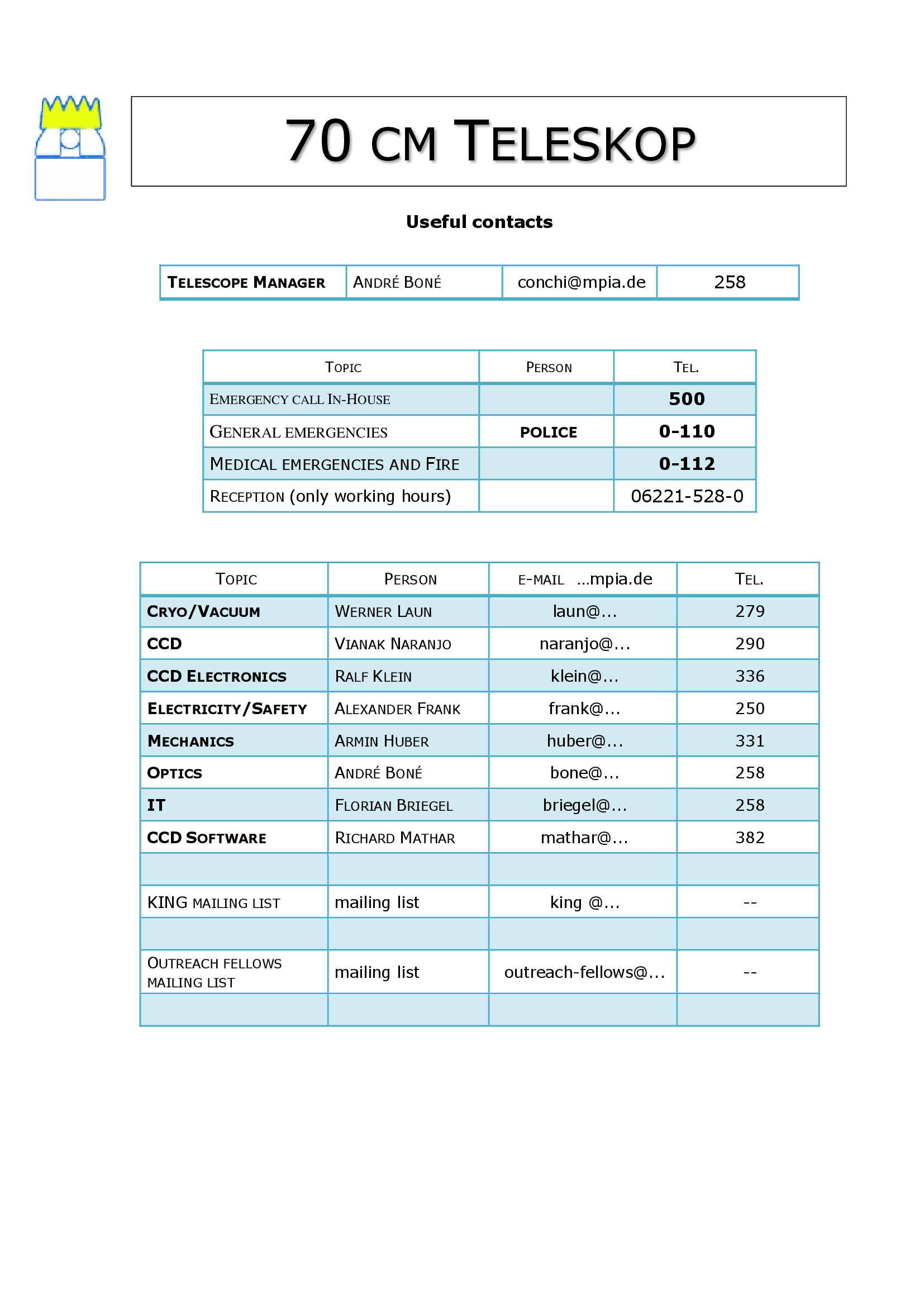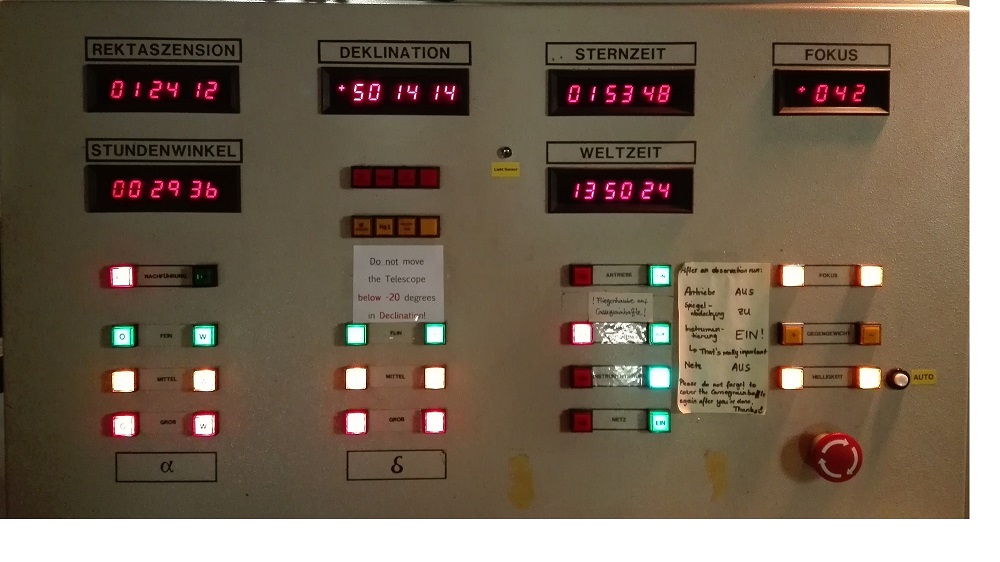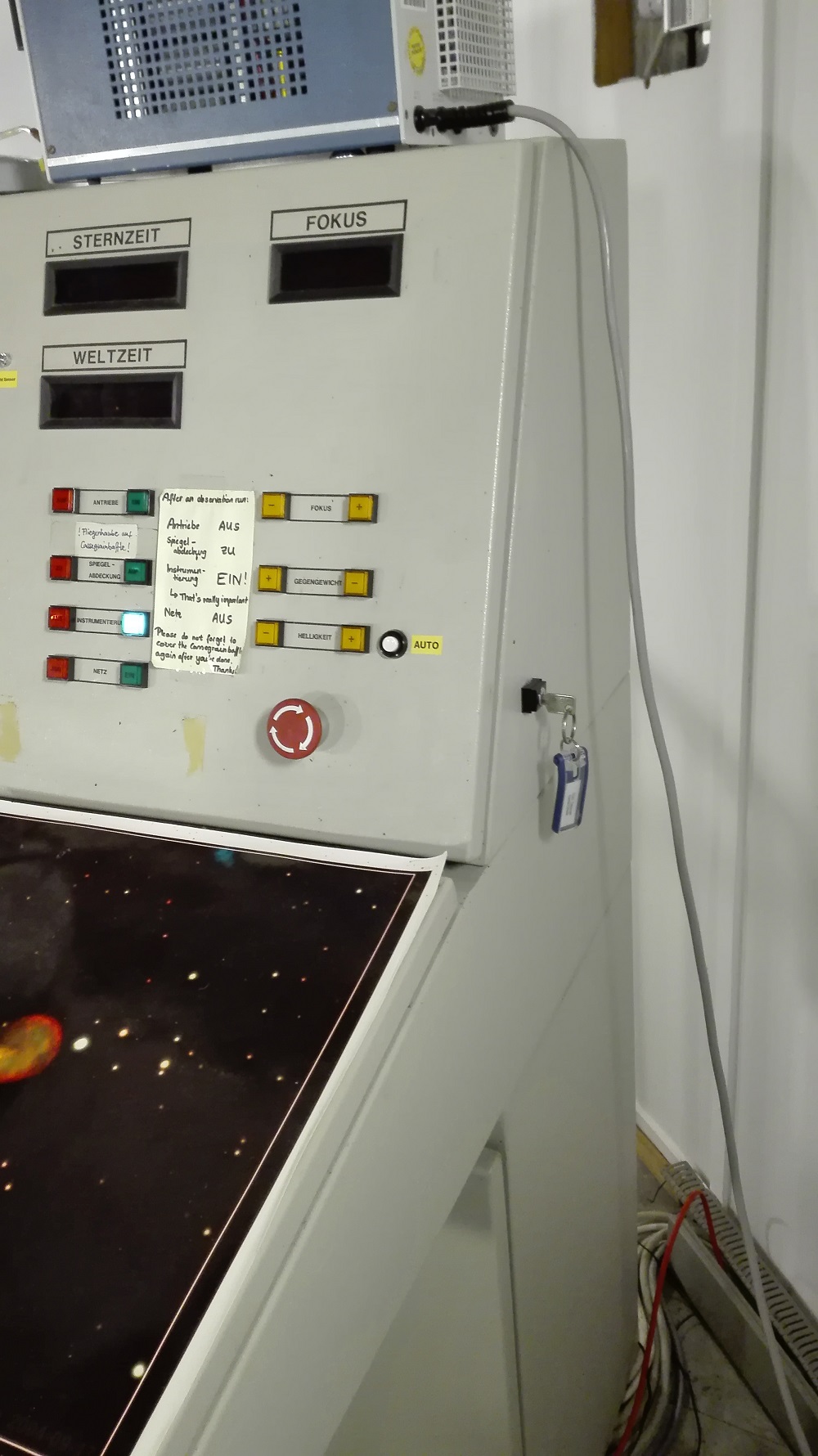- IMPORTANT
- If you do any significant activity (like observing, repairing, changing, cleaning, etc.) please report on our blog, by adding a new post. This is our logbook, and essential to keep things up and running. Thanks - your KING team.
- If you do not have access to the blog and you want to, please ask for your credentials to André Boné (bone@…).
KING upcoming events
CCD temperature and Dome temperature plot
In a linux computer you can simply run in the terminal:
okular king70cmTemp.pdf &
or as an alternative:
curl ftp://ftp.mpia.de/pub/ccd/king70cmTemp.pdf --output king70cmTemp.pdf
okular king70cmTemp.pdf &
Computer info
- The computer in the dome is called king.mpia.de (current IP: 149.217.45.16)
- Software:
- OpenSuse_Tumbleweed
- ds9
- pyRAF
- idl
- The users@king are (for passwd's, user admin etc, please contact king@…):
- staff: default user to login and do something, also for observations.
- ccd: CCD engineering account.
- praktikum: to do F30 advanced lab course.
- check http://www.linfo.org/uid.html if you need to know about linux users
Observing with KING - Operation manual
- Operations manual This document contains the instructions of how to operate the Telescope, the dome, and the CCD. We encourage you to use it.
It also includes the troubleshooting section presented in this web page, here bellow. You will find a printed copy at the dome.
- General sources of information
- check KING website: https://svn.mpia.de/trac/gulli/king/wiki/WikiStart
- email to KING list: [mail to: king <at> mpia <dot >de]
- physical access to the telescope is usually granted after having done the cryo safety and operations training (contact Werner Laun: laun@…)
- for operating and observing with KING, you should do a first run together with trained personel, please contact our mailinglist for coordination: king@…
- if you are a local student, who needs or wants teaching experience, you might be interested to get training on both cryo and telescope operations via tutoring our advanced lab course F30: (link)
- Usable nights
- Usable are night where you see stars... Tom Herbst (homepage) run an all-sky camera for a good part of the year, and estimated about 75nights / year, or 6n/month, although we don't have the seasonal statistics, so there might be considerable annual trends. In fact, Tom reported
Note that these were nights that started out very promising. Sometimes the clouds came in, on the other hand, on other nights it undoubtedly cleared up in the middle of the night. The final comment is that these nights came in bunches… perhaps 4 good days in a row followed by nothing for a week or two.
- Usable are night where you see stars... Tom Herbst (homepage) run an all-sky camera for a good part of the year, and estimated about 75nights / year, or 6n/month, although we don't have the seasonal statistics, so there might be considerable annual trends. In fact, Tom reported
- Science Filters
- The complete set of filters are normally stored in a big box just underneath the telescope structure on the dome.
- The complete list of the available filters and their characteristics can be found here bellow in this table and in the following link, where you will have also access to their transmission data: https://svn.mpia.de/trac/gulli/king/wiki/WikiStart/FilterSpecs.
-
- The filters are switching manually with screwdrivers. There is not any automatic mechanics to change filters.
- The filters are installed for operation in a slide with a maximum of 5 positions. This slide is inside the aluminium box (shown in the figures bellow).
- Do NOT loose the small screws to fix the cover!!
- In case you see a filter should be cleaned, please contact the telescope manager: conchi <at> mpia <dot >de
- Telescope operation and Dome operation
- The instructions of how to operate the Telescope and the Dome are in the "Operation manual" (linked at the beginning of this section). Please read them in advance.
- You will find, for example:
- The explanation of the different buttons of the telescope console control panel.
- How to turn on and off the telescope.
- How to recalibrate the Right ascension and Declination axis.
- How to recover the telescope when it out of limits, either declination or right ascension.
- Flat field operation Section to be written.
- CCD operation
- Setting up the system
- 30-45 min setup time.
- Pumping the cryostat and Liquid nitrogen filling in the afternoon (only be trained personal!) The LN2 typically lasts for one night. The instructions are in this link: https://svn.mpia.de/trac/gulli/king/wiki/WikiStart/Instructions-LN2
- Read the detector (omitting the cryo-part)
- The instructions of how to operate the CCD are in the "Operation manual" (linked at the beginning of this section). Please read them in advance and take with you during your working session.
- Attention: It is NOT recommended to interrupt the "ccdread" process with Ctrl-C !!! If you do so, and afterwards you don´t have a proper images, please read the "Operation manual" where it is explained how to proceed.
- Setting up the system
- Operation in winter time There is now an additional heater for the vacuum pump. During winter, the oil in the pump can get too cold, and the normal pump won’t start, although the motor is working, the pump is not and the pressure does not change from atmospheric. The motor would overheat, stop, cool down, and repeat for several minutes up to nearly an hour, until the radiating heat of the motor warmed up the oil in the pump - not ideal! Werner Laun therefore put a heat gun in the telescope dome (it is in the shelf where the gloves are). With that one could carefully heat up the pump until the oil is warm enough.
Observing with KING - Troubleshooting
- This is a list of possible main problems you could find during operation of the telescope and CCD.
Attention: This is not an exhaustive list. The instructions of how to deal with these problems are in the "Operation manual" (linked at the beginning of this section). Please read them carefully.
- If "NETZ EIN" button is not working.
- The control panel seems completely dead, nothing blinks or reacts.
- If "INSTRUMENTIERUNG EIN/AUS" button is not illuminated, although you think it should be.
- If ccdread displays the error message "ERROR: No FITS file produced".
- If ccdread produces a FITS image where all values are zeros.
- If clock is lost, and the display show only zeros
- You need to follow the instructions in the "Operation manual": How to reset the telescope clock.
Science cases
- Trifon Trifonov: Novae hunting in M31 (or similar)
The rate of Novae in M31 is about 30-50 per year! That means that one has very good chances to spot a Novae at maximum brightness. Once with students we discovered one in M31 and even had an astronomical telegram. It is a fun project and many professional and amateur astronomers are hunting for Novae in M31 (even supernovae ...). Actually to hunt Novae one must be very fast to announce a discovery since many other people around the globe are also observing even with robotic telescopes. This project would require someone to develop a fast pipeline which cross-check for new objects in the field and performs photometry on them. It shouldn't be so complicated to be done. [...] Alternatively [http://diffractionlimited.com/product/maxim-dl/ MaximDL] is a handy amateur tool for that and LSW has some experience with this software. Particularly for science, any data from the Novae light curve helps to better understand the Maximum magnitude vs. rate of decline (MMRD), which has a potential to be used as a distance indicator. The FoV of the KING telescope (~19 arcmin diameter) is a bit small, but still it can be used for the central part of M31 (where most of the Novae occur if i am not mistaken). What I can recall is that Novae in M31 typically have apparent magnitude in R about 16 mag. The exposures usually about 900 sec for a good S/N but often I take several (about three) in BVR and only from time to time in H+alpha. So 900sec = 15 min + overhead ~ 5 min equal to ~ 20 in filter. If we take 3 exposures in each filter = 1 h. BVR = 3 h/ night Alternatively, if this time is too much then only images in R are sufficient to discover Novae.
- Mapping Andromeda
- With our 19arcmin field-of-view (FoV) we can do a mosaic of pictures for Andromeda. One can later combine all the images and reconstruct the Andromeda galaxy with very high signal to noise image. Thats might be a cool to project for a student. Also, M51 is a good object of interest (the supernovae rate there is very high!).
- Asteroids (any experts around)
- Our CCD photometry lab course teaches how to do resolved star photometry in a cluster, for scientific projects you probably would want a better site than Konigstuhl...
- Spectroscopy?
- Precise photometry on very bright, variable stars?
KING users
There are a group of people interested in observing with the KING telescope.
These persons have key access and experience to handle the hardware.
If you want to join them or simply use the telescope, please send an e-mail to KING list: [mail to: king <at> mpia <dot >de].
Attachments (7)
- SwitchFilters_FilterInSlot.jpg (2.1 MB) - added by 7 years ago.
- Telescope-Control_module.jpg (147.9 KB) - added by 7 years ago.
- 2020-06-Contact people-1.png (216.4 KB) - added by 5 years ago.
- 2019-05-10-Filters_cover.jpg (329.5 KB) - added by 5 years ago.
- Key_at_the_telescope_control_module.jpg (310.6 KB) - added by 5 years ago.
- 003-70cmTeleskop-Operations manual-v3.1.pdf (1.2 MB) - added by 5 years ago.
- 2023-01-Contact people.png (70.5 KB) - added by 2 years ago.
Download all attachments as: .zip





